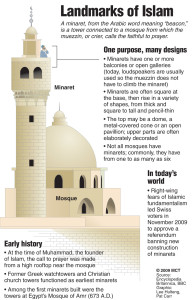Switzerland: Minarets and Immigration

The result of the minaret referendum is a clear and troubling sign of the serious problems Europe has been facing with immigration and integration, particularly with regards to the Muslim, Middle Eastern world. While Switzerland’s move to block all construction of minarets may be extreme and inflammatory, it is hardly a surprising development given Europe’s immigration story. Switzerland’s current precarious situation is a fairly common combination of a surge in strong European nationalist tendencies and the refusal of many Islamic immigrants to conform to European liberalism.
Europe did not be come an attractive location for immigrants until after the conclusion of World War II. For much of the 19th and 20th centuries, most people chose to leave Europe for more opportunities in America, giving the United States ample experience in dealing with immigrants successfully, and helping give rise to the magnificent country America is today. Unfortunately, the same could not be said of Europe, where immigrants were invited soley to supply unskilled labor that increasingly fewer native Europeans were willing or able to provide. Originally assuming that the immigrants would leave after obtaining enough money, Europeans later decided to accommodate new arrivals as new citizens, but after several decades, this strategy is starting to show some major flaws. Europe’s overly generous welfare state policies are keeping unemployment rates high, discouraging innovation and work, draining taxpayers’ coffers, and hurting Europe’s overall economic and social health. While America is a nation of immigrants whose population is highly diverse and accustomed to difference, European populations have been mostly homogenous for centuries. Immigration is disrupting and sometimes even destroying this phenomenon, causing some Europeans to turn towards far-right political parties like the Swiss People’s Party (SVP) of Switzerland (a leading supporter of the minaret ban), the Northern League of Italy, the British National Party of Great Britain, Jobbik of Hungary, Vlaams Belang of Belgium, the National Front of France, the National Democratic Party of Germany, and many other groups with similar nationalist preferences.
Europeans have long been reluctant to fully integrate immigrants into their society, generally discouraging them from taking skilled jobs, learning the language or pursuing political power. As a result, many European immigrants feel isolated and detached from their new homes, contributing to high levels of apathy and even resentment toward natives. Since they are routinely marginalized in European life and generally hail from countries that are very socially conservative, many Muslim immigrants are inclined to support Islamofascist views; surveys of European Muslims reveal that apathy, ire, and mistrust of their countries are high, and that around 40% consider Western society “decadent and immoral” and deserving of hatred. (There are a number of shocking and revealing studies on this subject, chronicled and collected in books like Bruce Bawer’s While Europe Slept and Mark Steyn’s America Alone.)
It is evident just by examining the news of past years that Islamic extremism is a growing problem in Europe. Notable events like bombings in Madrid and London, widespread riots in Europe, and the Danish cartoons of Muhammed that provoked worldwide chaos show that this extremism is a problem that needs solving sooner rather than later. Banning minarets, however, is a counterproductive measure that will only further anger Muslims and fuel more conflict and misunderstanding. The ban does not deal with underlying problems of racism, integration, immigration, isolation and extremism. Europeans must open their eyes and get serious about developing successful immigration policy. They will need stricter controls on new immigrants, as well as better methods of assimilating newcomers to the native culture, language, and society. Muslim immigrants, for their part, must be more willing to conform to European ideas in order to avoid a surge of Islamofascism. Only when both sides revise their approaches will far-right ideas and politics like the minaret ban lose their steam and fade away.
(Article by Derek Sun.)